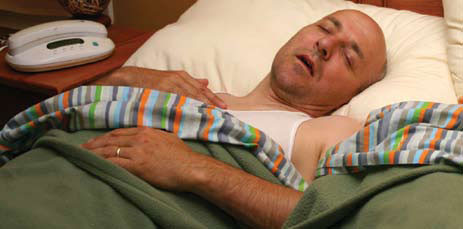Sleep apnea—unmasking a nighttime health risk
It affects an estimated 18 million Americans and is the leading cause of daytime drowsiness, yet many of those who suffer from sleep apnea are unaware that they have a chronic condition with life-threatening consequences.
Characterized by pauses in breathing—sometimes hundreds of times per night—that disrupt sleep three or more nights a week, sleep apnea often goes undiagnosed and therefore untreated. In fact, because it occurs during sleep, a family member or loved one is more likely than the sufferer to suspect something is wrong.

If left untreated, sleep apnea can have a number of life-threatening consequences. When breathing ceases during the night, less oxygen makes its way through the body, causing measurable blood deoxygenation. This results in a high concentration of carbon dioxide in the body, which can precipitate a heart attack or stroke. High blood pressure and other cardiovascular diseases also may result.
The impact of untreated sleep apnea on the individual's quality of life is high. Because they awaken multiple times throughout the night, individuals with sleep apnea tend to suffer from excessive daytime sleepiness, which can impact productivity and even their ability to drive safely. Sleep apnea can affect memory and concentration as well as cause morning and nighttime headaches, weight gain, impotence, heartburn, and personality changes.
Patients with undiagnosed sleep apnea use health care resources at higher rates than others. A 1999 study from St. Boniface General Hospital Research Centre in Canada found that, for the 10 years prior to diagnosis, physician claims for patients in whom sleep apnea was eventually diagnosed ($3,972) were twice that of age-matched individuals in a control group ($1,969). The researchers noted that it is possible that the findings do not reflect sleep apnea per se but the presence of risk factors for the condition, such as obesity and alcohol consumption.
The AVMA Group Health and Life Insurance Trust paid claims related to sleep apnea in excess of $552,000 in 2007 and $568,000 in 2008.
Types and risk factors
There are two types of sleep apnea, obstructive and central. Obstructive sleep apnea is the most common form and is caused by an obstruction of the airway during sleep. The blockage is usually made by the soft palate or other soft tissue in the rear of the throat collapsing, making breathing difficult or impossible. Snoring is a prevalent sign of obstructive sleep apnea.
Central sleep apnea is caused by a failure of the brain to send the correct signals to the body to breathe. With central sleep apnea, the body never attempts to breathe and can "overlook" doing so for periods of time. Central sleep apnea frequently occurs with obstructive sleep apnea, but it can occur alone. Because the airway is not blocked, snoring typically does not occur with central sleep apnea.
Both forms of sleep apnea cause breathing to stop repeatedly during the night, often for more than a minute. With each apnea event, the brain briefly arouses the sleeper so the person will resume breathing normally. This is usually accompanied by a loud snort or choking sound.
Although the typical sleep apnea patient is an overweight male older than 40, sleep apnea affects men and women of all ages and weights.
Those most at risk are individuals who are overweight or who have high blood pressure or a physical abnormality of the nose, throat, or other parts of the upper airway. People with a family history of sleep apnea and those who smoke or consume alcohol also are at higher risk of having sleep apnea.
Of particular interest to practicing veterinarians—who have a higher-than-average risk for allergies, asthma, and sinus conditions—researchers believe that those conditions may influence whether a patient will develop sleep apnea. In a 2006 study, researchers from the University of Cincinnati and Cincinnati Children's Hospital Medical Center found that young women who have asthma are twice as likely to experience habitual snoring, the primary symptom of obstructive sleep apnea.
Treatments for sleep apnea
The good news is that, with proper diagnosis, effective treatments for sleep apnea are available. Those who suspect they have sleep apnea are encouraged to keep a sleep diary in which they or a family member tracks frequency and volume of snoring, sleep quality, trouble breathing, and other sleep issues. Their physician can use the information to help determine the appropriateness of additional testing for sleep apnea—usually an overnight sleep study in a sleep clinic.
Treatment decisions are based on the individual's medical history and the severity of the disorder. For minor sleep apnea, lifestyle changes are often effective. These include losing weight, avoiding alcohol, and quitting smoking. Sleeping on one's side, elevating the head of the bed 4 to 6 inches, and using nasal dilators can help. For people who suffer from allergies and sinus conditions, treating those conditions first may result in better sleep.
For moderate sleep apnea, the most common treatment is the use of a machine that maintains continuous positive airway pressure in the nasal passages. The machine pushes air through the nasal passages at a pressure high enough to keep the airway open during sleep, preventing lapses of breathing to give users a more restful night's sleep. Dental devices that open the airway by bringing the lower jaw or tongue forward during sleep also have proved effective.
In severe cases of sleep apnea, surgery to increase the size of the airway is an option. This includes removal of tonsils, adenoids, or excess tissue at the back of the throat or inside the nose, or reconstruction of the jaw to enlarge the upper airway.